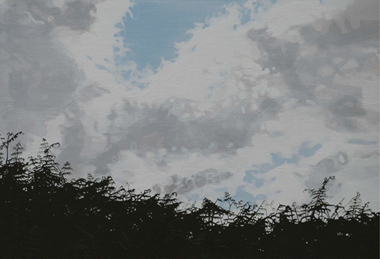 |
Ann Quinn, Bracken, acrylic on board, courtesy the Cross Gallery |
Ann Quinn’s twelve paintings at the Cross Gallery consist mainly of oil on board with the exception of three images that are painted in acrylic. Quinn uses a minimal colour pallete of blues, greys and very dark greens and the canvas is generally no greater than two feet across. The inspiration for the images differs greatly and the title of the show alludes to this effectively. Autumn in Middle East refers to the time Quinn spent traveling through Iran in the autumn of 2006 and Summer in West refers to the residency she took in Glenveagh National Park in the summer of 2007. The resulting images depict the landscape Quinn was immersed in and are at the same time very similar yet notably different. The images focus generally on either a silhouetted tree or a mountain range against the sky as a backdrop. Around 70% of the canvas is dedicated to the sky and in some cases the viewer is left with only 10% of the image as an indication of the location. The notion emerges that the same sky covers us all.
 |
Ann Quinn, Looking onto Lough Veagh, oil on board, courtesy the Cross Gallery |
The image that greets you first is a scene from her time in Gleanveagh in Donegal. The image, Looking onto Lough Veagh, differs from the others for many reasons; the composition is classical, there are a variety of greens explored, and the land-to-sky ratio gives dominance to the grass that leads the eye to a crystal lake in the middle distance. The technique used is not soft sweeping paint strokes but rather exact, well thought-out marks on the canvas. The resulting painting is romantic and conjures up images of Casper David Friedrich, in particular his painting Solitary tree .
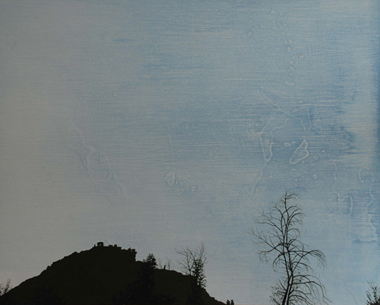 |
Ann Quinn, The fire temple at Esfahan, acrylic on board, courtesy the Cross Gallery |
The same space displays two of the three acrylic paintings. This is a medium that slightly alters Quinn’s approach as it seems to allow her more freedom. Cloud mimicking and Bracken are these pieces and they are quite simply beautiful. Bracken displays Quinn’s skill at capturing clouds; the canvas is filled with soft mesh-like clouds, the conifers in the forefront reach up into this open space. The day is not clear though, and the grey underbelly of the clouds creates tension in the piece. A sense of foreboding is dominant in Bracken.
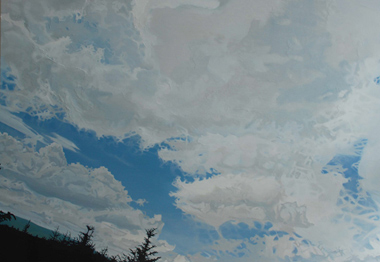 |
Ann Quinn, Sikta Spruce sky, oil on board, courtesy the Cross Gallery |
Autumn in Middle East, summer in West is very cinematic is its aesthetic. The images appear as if cutaways in a film. In particular, one of the largest pieces on display, Sikta Spruce sky (57 cm x 82 cm), evokes the long, rolling scenes of life occuring in front of an unmoving camera in Chantal Akerman’s documentary Sud. The tilted perspective further heightens the cinematic realisation.
In Lone Scot’s pine, Quinn paints with great attention to texture. She approaches the sky and earth as if one and the same and paints them as though they were the parched earth of a desert plain. The dense cloud above the barren ground gives Quinn the surface necessary to enact her textural experimentation in the piece. Large cracks are painted and appear to (under the guise of the sky and earth) represent the structure of the skin under a microscope.
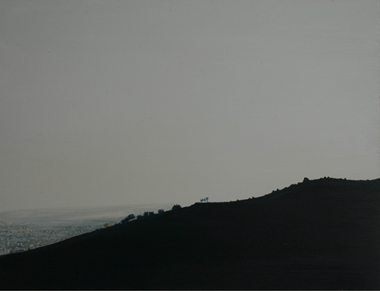 |
Ann Quinn, Tehran, oil on board, courtesy the Cross Gallery |
The images depict the “half light of the end of day.” 1 They possess the strange calmness that the end of the day brings. A sense of solitude is also apparent, a serenity of the lone observer as they look upon the surrounding lanscape. That little tent of blue is a prime example of this; it is painted as though lying down and looking straight up at the sky as it passes you by. Pieces of foliage hang into the edge of frame; they do not go unobserved by the peripheral vision. The cinematic aesthetic is again here and the common scene of lying in park staring up at the sky is evoked.
The city scape does not go unnoticed; Yazd, seen from the Towers of Silence depicts the low, flat-lying Iranian town of Yazd under the night sky. A domineering mountain range rises behind it and the moon hangs low in the distant sky. The cloudless sky makes the air feel cool and the lights emitted from the buildings form the structure of the town. Hanging directly opposite this is Red deer (back to Donegal); again a shadowed mountain against the sky is observed along with the small silhoutte of a red deer as it apparently stares directly at the viewer.
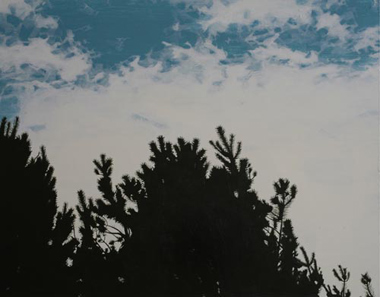 |
Ann Quinn, Cloud mimicking, acrylic on board, courtesy the Cross Gallery |
Quinn’s execution in Autumn in Middle East, summer in West is exact and methodical, yet there is a softness and romantism present, resulting in images that are highly evocative. The common thread conecting the images is the sky; by focusing on the sky rather than the terrain, it is clear that it is this commonality that is Quinn’s objective. It is unusual to see an exhibition that moves away from the issues of land, particularly when one considers the locations depicted. The work feels very personal and the use of the perplexing time that is the day’s end works well in exploring the emotions that the land offers up to us. As you look at the images, time seems to stand still and you truly feel yourself in Quinn’s shoes, looking through her eyes, even if they are resolved in focusing towards the heavens.
Laura McGovern is a photographer practising in Dublin.